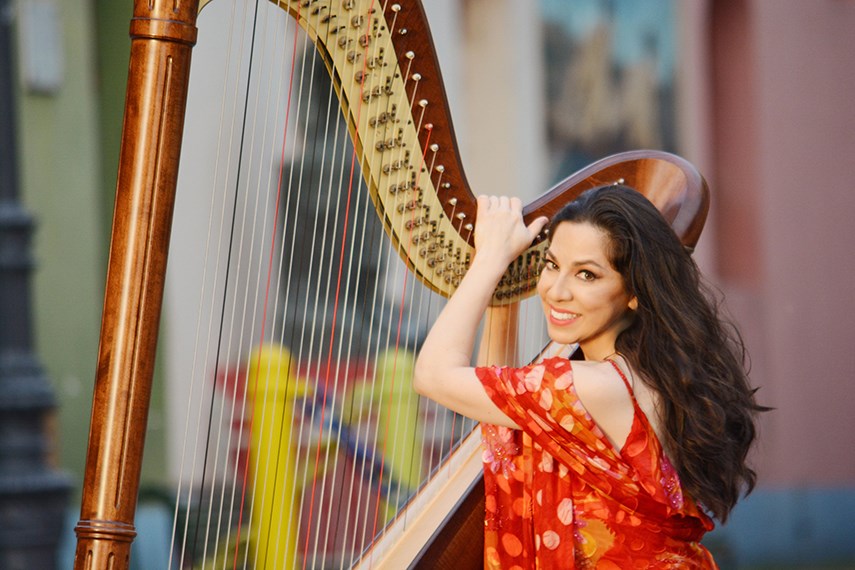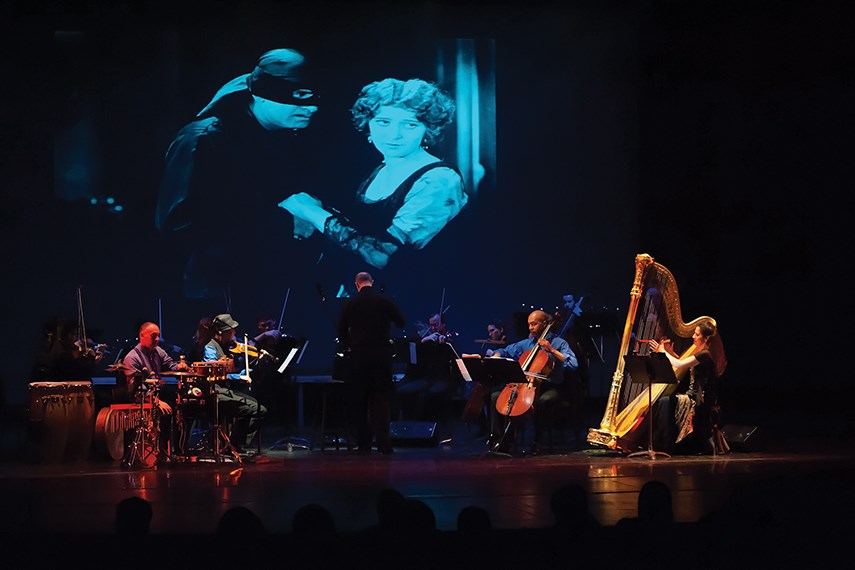Tango del Cielo, featuring guest accordionist Jelena Milojevic, Kay Meek Arts Centre, Saturday, Nov. 9, 7:30 p.m. as part of the World Accordion and Tango Festival (watf.ca).
The World Accordion and Tango Festival, taking place this week mainly in Victoria, B.C., includes one special evening at West Vancouver’s Kay Meek Arts Centre on Saturday, Nov. 9, featuring harpist Anna Maria Mendieta’s Bay Area ensemble Tango del Cielo performing with special guest accordionist Jelena Milojevic.
Born and raised in San Francisco, Mendieta has been the principal harpist with the Sacramento Philharmonic and Opera for almost 20 years. She also plays with several other ensembles in the Bay Area including the San Francisco Opera, the San Francisco Ballet and the San Francisco Symphony.
Mendieta also represents the San Francisco Symphony in outreach concerts at Bay Area schools in an ongoing program called Adventures in Music.
As leader of her own ensembles, Tango del Cielo and Cielo, she has toured the world performing tango, flamenco, Spanish classical and Latin Jazz.
Considered a pioneer in introducing the harp into the tango repertoire, Mendieta’s performances this week at the World Tango and Accordion Festival are her first in Canada. She spoke to the North Shore News about her instrument of choice and adding its voice to the world of tango.
North Shore News: How did you choose the harp as an instrument?
Anna Maria Mendieta: As a five-year-old I was intrigued with the sound of the harp. Both of my parents were musicians. My father played classical guitar, my mother played accordion and piano and we were raised listening to classical music in the house all the time. They had a recording of Tchaikovsky’s “Romeo and Juliet.” They told me the story and I was intrigued with the music. In this piece the orchestra plays its fullest and then there’s a sudden hush and a beautiful harp solo happens. I remember the day exactly and I would have them play the recording over and over again. I just knew that day I wanted to play the harp. It took two years to convince my parents, begging them, that I wanted to play it, so I started when I was seven.
North Shore News: You needed to convince them about the harp?
Anna Maria Mendieta: That’s right. Everybody had a choice of instruments in the house. My father used to collect instruments – he took great pride in that – but harp happened to be the one instrument that we didn’t have in the house. It took a bit of convincing.
North Shore News: Is there much tango music written for harp?
Anna Maria Mendieta: Traditionally, no. Harp is not a traditional tango instrument. Back in the1930s there was one orchestra, (led by Osvaldo) Fresedo and he incorporated harp into his orchestra. It was just part of the the background and would supply maybe glissandos here and there – it was very lush and romantic but typically harp is not considered a traditional tango instrument.
It was in 2004 when I was first introduced to Astor Piazzolla’s music. Piazzolla is one of the most famous tango composers of Argentina. He passed away in the 1990s. His music is very different. He stretched the envelope of the traditional tango and incorporated some jazz into his music as well as modern classical music. He studied with Nadia Boulanger. When he was in France studying with the composer he kept it a secret that he played the bandoneon. One day on a break he pulled (the instrument) out and played for her and she was so taken by it she said, “Astor that is your voice, from now on you should incorporate the tango into everything you do.” He did but he wasn’t accepted back in Argentina – the Argentinians were very strict as to how tangos should be played. The rest of the world accepted his music, and when Argentina saw that, they welcomed him back to the point where the government even paid him to compose new pieces every week for performances in Concerts in the Square.
Piazzolla was very much a beloved composer by the time of his death. When I first heard his music I was blown away. His music is so unique, it’s so different from any other classical music. He has the instruments play percussively and that’s what was so intriguing. I searched for his music. I looked around for harp arrangements and people would tell me, “It can’t be done. You can’t play tango music on a harp.” So I had to create my own arrangements. When someone says you can’t do it that motivates me even more. Just stick with it and try. I started creating my own arrangements and then I was asked to present and premiere these arrangements at the National Harp Conference.
At the time I was very lucky to meet Piazzolla’s own musicians and they have since written music for me. I think one of the most influential composers that I’ve worked with was Pablo Ziegler, who was Piazzolla’s pianist for 10 years and after Piazzolla died Ziegler went on with his own music. And he was told at the time, “Oh, you can’t perform without a bandoneon, you can’t do it with just piano.” Well, he proved them wrong to the point where he won the Grammy for the Best Tango Album in 2006 and that’s when I met him.
He took me under his wing and we started creating arrangements together and exploring different sound effects with the harp and ways to mimic sounds the traditional tango instruments were doing. We found ways to make it work on the harp and when he finished his very first arrangement he said to me “OK, you go and do what no one else has done before.” It was like a validation and then the other composers accepted me and wrote music for me. I’m just so grateful.”

North Shore News: Is the repertoire for Tango del Cielo based on that material?
Anna Maria Mendieta: Yes, it is. We are incorporating his arrangements, Daniel Binelli’s arrangements (a bandoneon player who played with Piazzolla), as well as our own arrangements for the show. We’ll be playing some music from silent films too because that was one of the ways tango music was first introduced to the United States. We will be playing a very famous tango everybody knows called “Jalousie.” What people don’t [generally] know is it was originally written for the silent film ”Son of Zorro” in 1925, starring Douglas Fairbanks Sr. It was written by a silent film composer in Denmark (Jacob Gade) and titled “Tango Jalousie.”
North Shore News: What sort of logistics are involved in travelling with a harp?
Anna Maria Mendieta: If I can drive I take my own instrument. If I fly then I have to rent an instrument wherever I go. Connecting with symphony harpists has been my solution -– most symphony harpists have more than one harp and we know we can trust each other with our harps. When they come to my area I let them use mine and it’s the same when I go to their area. There’s a wonderful camaraderie among harpists around the world.
Accordionist Jelena Milojevic will join Tango del Cielo for two Piazzolla pieces: “Libertango,” (a 1974 composition symbolizing Piazzolla’s conceptual move away from Classical Tango into Tango Nuevo) and “Oblivion” (originally written for Marco Bellocchio’s 1982 Italian film adaptation of the Pirandello play, Enrico IV, starring Marcello Mastroianni and Claudia Cardinale).
Tango del Cielo:
Anna Maria Mendieta - Harp
Joseph Christianson - Violin
Sascha Jacobsen - Bass
Antonio Gomez - Percussion
Suzanne Mendieta - Flamenco Dancer
Count Glover - Tango Dancer
with guest accordionist Jelena Milojevic



